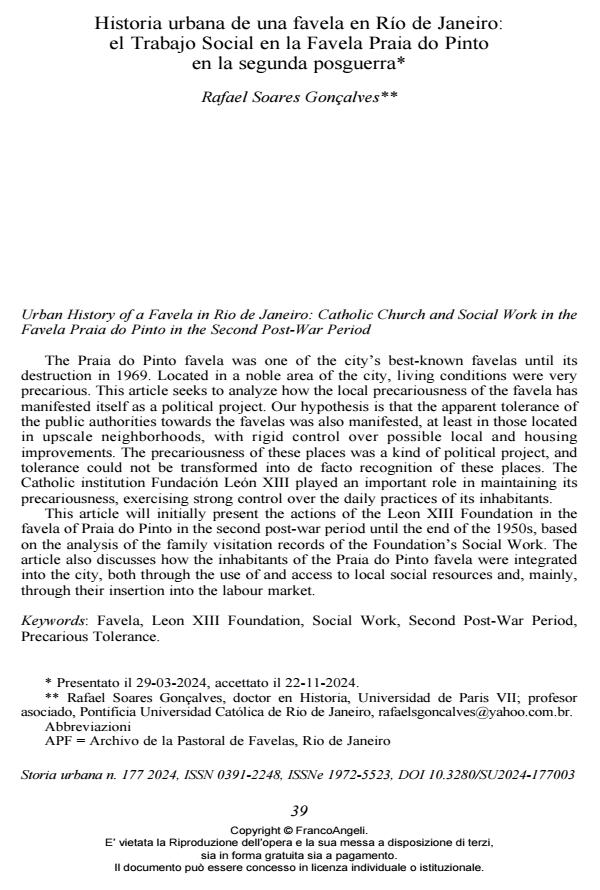Urban History of a Favela in Rio de Janeiro: Catholic Church and Social Work in the Favela Praia do Pinto in the Second Post-War Period
Journal title STORIA URBANA
Author/s Rafael Soares Gonçalves
Publishing Year 2025 Issue 2024/177
Language Spanish Pages 20 P. 39-58 File size 156 KB
DOI 10.3280/SU2024-177003
DOI is like a bar code for intellectual property: to have more infomation
click here
Below, you can see the article first page
If you want to buy this article in PDF format, you can do it, following the instructions to buy download credits

FrancoAngeli is member of Publishers International Linking Association, Inc (PILA), a not-for-profit association which run the CrossRef service enabling links to and from online scholarly content.
The Praia do Pinto favela was one of the city’s best-known favelas until its destruction in 1969. Located in a noble area of the city, living conditions were very precarious. This article seeks to analyze how the local precariousness of the favela has manifested itself as a political project. Our hypothesis is that the apparent tolerance of the public authorities towards the favelas was also manifested, at least in those located in upscale neighborhoods, with rigid control over possible local and housing improvements. The precariousness of these places was a kind of political project, and tolerance could not be transformed into de facto recognition of these places. The Catholic institution Fundación León XIII played an important role in maintaining its precariousness, exercising strong control over the daily practices of its inhabitants. This article will initially present the actions of the Leon XIII Foundation in the favela of Praia do Pinto in the second post-war period until the end of the 1950s, based on the analysis of the family visitation records of the Foundation’s Social Work. The article also discusses how the inhabitants of the Praia do Pinto favela were integrated into the city, both through the use of and access to local social resources and, mainly, through their insertion into the labour market.
La favela Praia do Pinto è stata una delle favelas più conosciute della città fino alla sua distruzione nel 1969. Situata in una zona centrale della città, presentava condizioni di vita molto precarie. L’articolo si propone di analizzare come la precarietà locale della favela si sia manifestata come progetto politico. L’ipotesi formulata è che l’apparente tolleranza delle autorità pubbliche nei confronti delle favelas si sia manifestata anche, almeno in quelle situate nei quartieri centrali, con un rigido controllo sui possibili miglioramenti locali e abitativi. La precarietà di questi luoghi era una sorta di progetto politico e la tolleranza non poteva trasformarsi in un riconoscimento de facto di questi luoghi. L’istituzione cattolica Fundación León XIII ha svolto un ruolo importante nel mantenimento della precarietà, esercitando un forte controllo sulle pratiche quotidiane degli abitanti. L’articolo presenta in primo luogo le azioni della Fundación León XIII nella fave- la di Praia do Pinto, nel secondo dopoguerra fino alla fine degli anni Cinquanta, basandosi sull’analisi dei registri delle visite familiari del servizio sociale della Fondazione. Si analizza poi il modo in cui gli abitanti della favela di Praia do Pinto si sono integrati nella città, sia attraverso l’uso e l’accesso alle risorse sociali locali, sia, soprattutto, attraverso l’inserimento nel mercato del lavoro.
Keywords: Favela, Leon XIII Foundation, Social Work, Second Post-War Period, Precarious Tolerance.
Rafael Soares Gonçalves, Historia urbana de una favela en Río de Janeiro: el Trabajo Social en la Favela Praia do Pinto en la segunda posguerra in "STORIA URBANA " 177/2024, pp 39-58, DOI: 10.3280/SU2024-177003